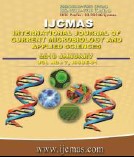


 National Academy of Agricultural Sciences (NAAS)
National Academy of Agricultural Sciences (NAAS)

|
PRINT ISSN : 2319-7692
Online ISSN : 2319-7706 Issues : 12 per year Publisher : Excellent Publishers Email : editorijcmas@gmail.com / submit@ijcmas.com Editor-in-chief: Dr.M.Prakash Index Copernicus ICV 2018: 95.39 NAAS RATING 2020: 5.38 |
The present study was conducted in the three blocks, namely Turenar, Tahkapal and bastanar block of Bastar district. These blocks are inhabited by the tribes, particularly Bhatra, Gond, Halwa, Maria, Muria, who are normally doing subsistence farming. Farmers of these regions are doing only traditional farming. Among these three blocks, 12 villages were selected randomly i.e. four villages from each block. From each village 10 vegetable growers were randomly selected by random sampling method. The total no of respondent to this study were 120 vegetable growers. The average productivity of vegetable crops in Chhattisgarh is 130.16 q per hectare which is below than the national average. It is mainly due to poor knowledge, facility as well as reluctant attitude of farmers in adopting the new technology. It is observed that a wide gap exist in production obtained and potential yield. Productivity per unit area can be obtained only by adopting improved varieties, hybrids as well as modern vegetable cultivation practices. The major bottlenecks in increasing production in this district were non availability of improved varieties (80%), Disease and insect resistant varieties (78%), high cost of seeds (77%), improper dose of fertilizer (74%), non-availability of skilled labour (74%) and price fluctuation of produce (58%), which discourages the farmers to adopt modern vegetable cultivation practices.
 |
 |
 |
 |
 |